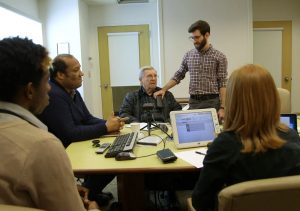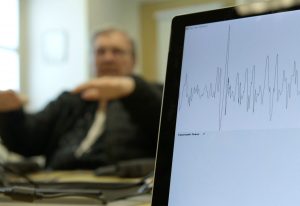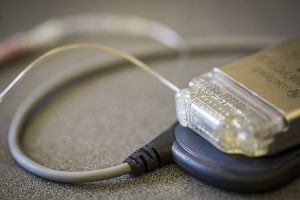Story by Wayne Gillam | UW ECE News

UW ECE graduate student Ben Ferleger (standing) calibrates study participant Fred Foy’s implanted deep brain stimulator with the CNT research team.
Ben Ferleger is keenly aware of the positive impact neurotechnology can have on quality of life.
“The technology we work with has the potential to really make people’s lives better. Essential tremor affects about five percent of the population over age 65, and as the population ages, the number of people affected is going to balloon substantially,” Ferleger said. “It’s going to become more and more necessary to find treatments for these sorts of conditions, not to mention psychiatric conditions and other motor disorders that affect people of all ages. The ability to really help people is definitely motivation for me.”
Ferleger, a graduate student in the University of Washington Department of Electrical & Computer Engineering (UW ECE), is conducting Center for Neurotechnology (CNT)-funded research seeking ways to improve deep brain stimulation. This is an effective, but imperfect, treatment currently used for essential tremor, Parkinson’s disease and other neurological disorders. Commercially available deep brain stimulation devices are always “on” after implantation, which can create troublesome side effects for the patient such as difficulty speaking, tingling in the limbs and uncoordinated or unbalanced walking. Periodic, time-consuming calibration to electrical stimulation levels in the doctor’s office is required.
“When you drink a glass of water you don’t care about talking, so stimulation to stop the tremor is important to get the glass to your mouth. But if you’re standing up to give a speech, you do care about talking and probably some tremor in your hand is acceptable. That’s the kind of adjustment we’d like the device to be able to make,” said Howard Chizeck, UW ECE faculty member and director of the UW BioRobotics Lab, where the research takes place.

The implanted device monitors when the patient wants to move their hands and delivers therapy accordingly to prevent hand tremors.
The research team is investigating ways to address these issues by “closing the loop” on deep brain stimulation in collaboration with CNT industry affiliate, Medtronic. In essence, this means using neural signals and biomechanical feedback from the patient’s own body to regulate the amount of therapeutic stimulation a person’s brain receives at any one time.
Closed-loop or adaptive deep brain stimulation reduces and helps manage side effects for the patient, while also saving precious battery life. This means fewer surgeries will be needed to replace batteries in the deep brain stimulator over its lifetime, which translates to reduced surgical risk and enhanced quality of life for the patient.
This research team has a track record of success. In 2017, they achieved the first in-human use of a brain-controlled deep brain stimulator for treating essential tremor and Parkinson’s disease. Since then, they have been building on that achievement. And, in the next few months they will be sending clinical trial participants home with fully implanted and embedded devices that will adaptively manage deep brain stimulation and track the patient’s response to the treatment over time.
The importance of investigational research devices

Medtronic provided the research team with the Activa PC+S, an implantable prototype device designed for clinical research trials, as well as technical support.
Collaboration with Medtronic has proven to be a dramatic accelerator for research in this domain. Medtronic provided the research team with the Activa PC+S, an implantable prototype device designed for clinical research trials, as well as technical support. The devices were implanted by CNT member physicians at UW Medicine, Dr. Andrew Ko and Dr. Jeffrey Ojemann. After implantation, the research team works closely with the clinical trial participant to monitor and adjust the device, testing and optimizing stimulation parameters and automated protocols, which are necessary for making the next version of the device useable in the real world.
“There is an enormous amount of regulatory work that has to be done in order to implant these devices in humans,” Ferleger said. “But because Medtronic has the resources to produce these sorts of devices, that means we get to do more interesting science, and they receive feedback on how to make their devices even better.”
Working with the device in human patients also enables the research team to collect a large amount of data capable of contributing to a better understanding of how the human brain reacts to electrical stimulation. Long-term, analysis of that data could give researchers at UW ECE and elsewhere insight into how to make neuromodulation devices that not only suppress tremors, but actually engineer neuroplasticity in the brain for healing and restoration of function.
Jeffrey Herron, UW ECE faculty member and principal investigator of several related studies in Chizeck’s lab, noted the challenges of developing neural devices capable of engineering neuroplasticity. According to Herron, partnerships with affiliates, such as Medtronic, helps to accelerate the movement of this technology into real-world clinical applications.
“The problems with neurological disorders and injuries are too complicated for industry to figure out by themselves these days, and the technical burden of building-up systems that can work in a human patient is too high for academics. The only way forward is by working together.”
Ferleger and Herron appeared to relish these challenges and both expressed gratitude for the Medtronic partnership.
“It’s not often that you get to take a practical output, like helping people, and also get a whole lot of insight into disease states, into how basic neuroscience works,” Ferleger said. “We’re really, really lucky to sit at that nexus.”
For more information about the CNT’s research on improving deep brain stimulation treatments for essential tremor, Parkinson’s disease and other neurological disorders, visit the UW BioRobotics Lab website.

